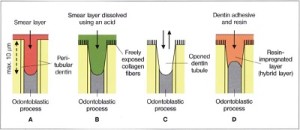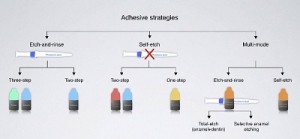Composite Resins and the Bonding evolution
The use of composite resin has become widespread in restorative dentistry thanks to the improvement of the bonding techniques. We call bonding procedure the various steps we take to achieve a chemical adhesion of the filling material to the natural tooth structure.
In order to understand the complexity of the problem we have to explain the fundamental differences between the enamel and the dentin.
The Enamel is the external layer of a natural tooth, is mostly inorganic and with a minimal amount of water within. Bonding to the enamel has been well known and accepted from the eighties. The adhesion is basically obtained applying an acid gel (mostly orthophosphoric acid) at various level of concentration (30/40 %) for a variable length of time (15/30 sec) to the tooth surface, washing it away and drying it. Doing so we create at microscopic level a huge number of irregularities that will be filled by the hydrophobic molecules of the composite resin, generating a very effective mechanical retention.
On the contrary the Dentin has a significant amount of organic components, cells and collagen fibres mostly, arranged in a tubular structure, with a considerable amount of fluids: not a good match with the hydrophobic nature of the composite resin.
 The breakthrough happened when we started to condition the dentin surface with acid agents similarly to what we used to do with the enamel (total etch), and we developed some molecule called primers, with a hydrophilic end able to penetrate the collagen fibres and the dentinal tubules, and a hydrophobic end able to connect to the composite resin.Today the successful bonding involves the creation of a hybrid layer that can infiltrate the collagen fibres and penetrate the dentinal tubules at one end, and connect chemically to the composite resins at the other.
The breakthrough happened when we started to condition the dentin surface with acid agents similarly to what we used to do with the enamel (total etch), and we developed some molecule called primers, with a hydrophilic end able to penetrate the collagen fibres and the dentinal tubules, and a hydrophobic end able to connect to the composite resin.Today the successful bonding involves the creation of a hybrid layer that can infiltrate the collagen fibres and penetrate the dentinal tubules at one end, and connect chemically to the composite resins at the other.
 A huge number of commercial products have been launched on the market in the last twenty years: some are based on a 3 components approach, Etch, Prime and Bond; others just two: Etch and Prime/Bond or Etch/Prime and bond. Recently several products claim to achieve the goal with a single component. An objective comparison in terms of efficacy is difficult and all the approaches are very technique sensitive.
A huge number of commercial products have been launched on the market in the last twenty years: some are based on a 3 components approach, Etch, Prime and Bond; others just two: Etch and Prime/Bond or Etch/Prime and bond. Recently several products claim to achieve the goal with a single component. An objective comparison in terms of efficacy is difficult and all the approaches are very technique sensitive.
For further information about Bonding system click here
